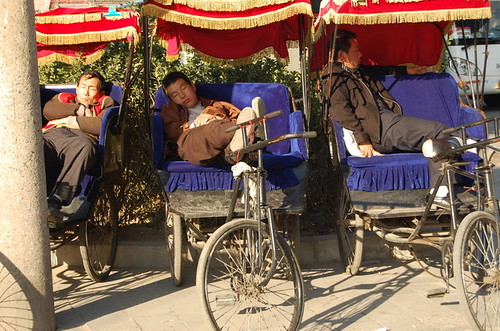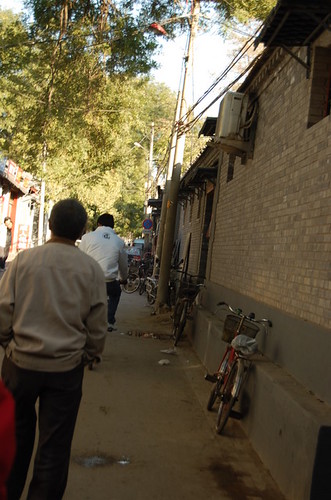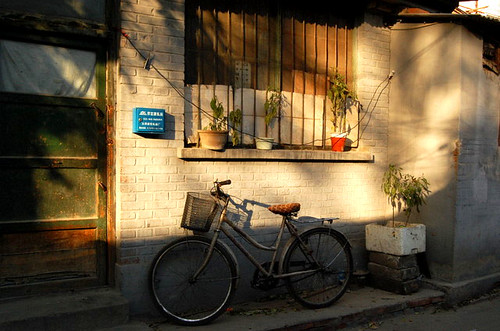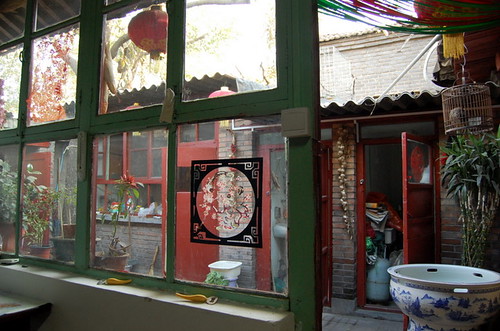Prior to my trip to Beijing, I imagined the city to be somewhat small and more laid-back compared to the rapidly developing and booming Shanghai in the south. But while this may be an accurate comparison, I haven't been to Shanghai so I can't tell you for sure, there is nothing small about Beijing and it it not quite so laid-back. Like a dart board with the Forbidden city as bull's eye, Beijing is circled by ring roads. I never expected to see 12-lane expressways (the outer lanes on each side for bicycles) such as the 2nd ring rd. that runs through Tiananmen Square and the Forbidden City.
You can't help feel that the city is in a breathless race to the 21st century, making up for lost time. There seems to be construction everywhere changing the city's lanscape forever. But tucked away from the sound of jackhammers and blaring car horns are little pockets of the past, charming remnants of the old way of life, threaded together by narrow lanes called hutongs. Some of the hutongs are so narrow (Qianshi Hutong, 40 cms wide) that only a thin person could walk though it, sideways.
a typical hutong
The word hutong was originally the Mongolian word for 'well' which were found on practically every street and in every square. They were central to the local's lives, being the major source of water supply which gave the locals the rare opportunity to socialise with one another. Like a honeycomb with many cells, residential complexes called siheyuan are scattered along these hutongs. The sihueyan best represent China's traditional housing architecture; familes and even whole communities live around a central open-air courtyard, in homes which were handed down the generations as gifts of historical importance. Depending on the family's social status, the designs ranged from simple and small-scale to large courtyards with carefully landscaped gardens and ornate roof beams.
The best way to navigate this charming tangled mess of alleys and doorways is on foot. Walking makes it easy to stop whenever you feel like to peek into courtyards through open doorways, to exchange nods and smiles with the locals that are going about their usual business, to take pictures of interesting things like street signs, purveyors of street food, charming windows and doorways. But if walking is not your thing or you are pressed for time, there are rickshaws for hire and you can even request for an English-speaking guide to show you around, which is what we did.
the bicycle is still the preferred way to get around
We climbed into our rickshaws at the junction of the Bell and Drum Towers and hired a nice lady guide. It was a very pleasant and leisurely journey, a far cry from the usual sounds of traffic, being taken around in bicycle-powered rickshaws. Pedaling her own bicycle alongside us, our guide engaged us in stories about this hutong or that one, and which prominent person, minister, mother of which empress, lived by that courtyard, and what drama went on beind the walls of that sihueyan.
We rode past children rushing home from school, their backpacks bouncing with each step; men and women and chidren and elderly alike rode past us in bicycles of their own, jingling their bells in greeting or warning, depending on the situation; old men sat outside in the shade large trees playing checkers; we passed a butcher shop, a fishmonger, countless fruit stands, doorways adorned with Chinese characters, grey brick walls decorated with ornamental tiling, windows lined with old bent leather shoes, a clothesline with underwear in varying shapes and sizes.
We were invited for a short visit inside one of the homes that was tucked away at the end of narrow passageway through which we had to walk single-file. We stepped into a tiny courtyard shaded by a mandarin orange tree decorated with red Chinese lanters and strings of red and green crepe paper. Chili plants lined the window sills, strings of garlic hung on the walls outside the kitchen and a caged owl perched above goldfish swimming inside a big blue and white vase. We were led by the lady of the house into one of the rooms (from which I took a photo of the courtyard below) which doubled as a guest room and living area. With the help of our guide who translated for both parties, we chatted with her while we sat around a simple wooden table munching on plum candies. We asked questions about her family and her life in the hutongs which she seemed only too happy to answer.




6 comments:
I think seeing these snippets of local daily life is one of my favorite parts of visiting another place :) Your photos have really captured this quiet corner of Beijing...I'll be bugging you for photo tips soon!
Me too! I look forward to the local life, it's such a treat to be like their guest in their city. And bug away! I'll be happy to help in whatever little way I can. :)
Your photos are so crisp and colorful! I think Beijing would be interesting to visit at this point in time as they ramp up preparations for the coming olympics ... definitely on my must-visit list! Hope to be able to make it there in 2008. =)
Thanks, wysgal. :) I hope you get to make it there too, you would love it. Even after the Olympics would be a good time, the hoopla would be over and there will be, im assuming, less roadwork and construction all around.
I'm so glad we don't have hutongs here. With my holiday bloated belly I probably wouldn't fit the narrow ones!
haha! I so know what you mean! :)
Post a Comment